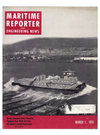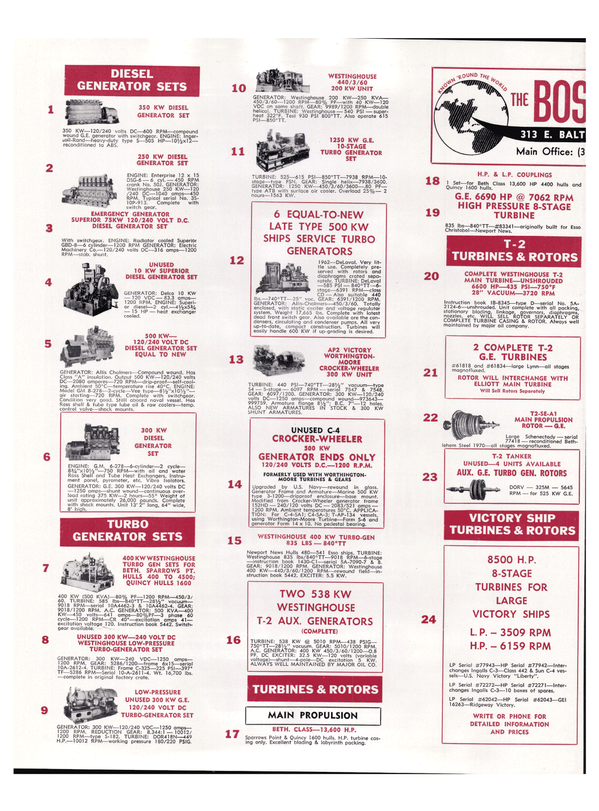
Study Indicates U.S. Waterborne Trade To Triple By Year 2000
The domestic waterborne commerce of the United States is projected to triple by the year 2000, according to a study recently released by the Maritime Administration.
The study, which was carried out for the U.S. Department of Commerce agency by the international management consulting firm of A.T.
Kearney, Inc., reflects a detailed examination of current traffic flow patterns of each of the domestic marine transportation segments—inland waterways, domestic ocean and Great Lakes carriers. It also assesses the economic and competitive forces that are expected to influence their operations during the remainder of this century.
Tonnage handled by these three segments, which aggregated 892 million tons in 1969, is expected to rise to 2.7 billion tons by the year 2000.
Currently, the water carriers account for 17.6 percent of the domestic tonnage movement, 26.9 percent of the total freight ton-miles, but only 2.3 percent of the freight revenues.
Tonnage handled annually by the inland waterways segment is expected to more than double, reaching 869 million tons in the year 2000. The domestic ocean segment, encompassing the coastwise and intercoastal movements, as well as the noncontiguous trades (Puerto Rico, Hawaii and Alaska), is projected to show a 326 percent increase to 1.5 billion tons.
The Great Lakes marine tonnage is forecast to double by 2000, reaching 325 million tons.
It is predicted that by the year 2000, fossil fuels will account for 1.7 billion of the 2.7 billion tons handled by the marine mode, with crude and refined petroleum accounting for 1.4 billion tons of this.
INLAND WATERWAYS The inland waterways system generally is a very efficient mode for transporting bulk commodities and semifinished goods, having experienced a 40-fold man-hour productivity increase over the past four decades.
However, the points of interface at ports between modes of transportation were found in the study to be far behind the level of available technology.
The need for concentrating attention and resources on this problem over the coming years is documented in the study. At present, it is not unusual for cargo handling costs at terminals to equal or exceed direct transportation costs of a typical domestic marine shipment.
A second area for concentration cited by the study is relief of capacity restraints on main thoroughfares.
Beyond that — and depending on the nature of any shifts in the sources of energy—developments appear favorable for the Inland Waterways Trade Area during the 25-year timeframe of the study.
To realize the potential, though, the industry will also have to be successful in obtaining reasonable support to assure practical water resource development and pollution abatement policies, the report concludes, along with adequate waterways project funding.
DOMESTIC OCEAN The Domestic Ocean Trade Area is expected to experience the greatest increase in traffic among the three areas, more than quadrupling present tonnage to 2.22 billion by 2000.
The domestic ocean coastwise traffic is dominated by petroleum and chemical bulk commodities movements.
Thus, the trade depends on the direction of energy-related policy.
Trade to and from Puerto Rico is afforded the best service levels of any similar traffic lane in the world, with more than 400 sailings per year.
Containerization has made the trade profitable for carriers since the mid- 1950s. However, the study indicated that this custom may have been eroded, and rate relief may be necessary during the coming years if the service level on which the Puerto Rican economy depends is to be maintained.
Trade to and from Hawaii principally is consumption-oriented, with some back-haul of agricultural commodities.
Future trade is expected to involve Alaskan oil shipments ; in fact North Slope development is expected to determine the future direction and growth of trade to and from Alaska.
GREAT LAKES The marine mode now carries more than 72 percent of all tonnage among the industry and population centers on the Great Lakes. This is the largest percentage penetration among the three trade areas. In terms of volume, it is the smallest and is expected to grow at the slowest rate. Present tonnage is projected to slightly more than double by the year 2000, according to the study, at which time it will represent about 10 percent of the total domestic marine market.
The dominance of the marine mode in Great Lakes traffic is expected to continue. Growth, however, depends on future steel industry plant expansion near the Lakes.
Most of the Great Lakes tonnage represents iron ore, limestone and coal for the steel industry, with some coal shipments for power generation as well. A potential opportunity for the marine industry to expand its markets through movement of Western coal via Duluth-Superior to Great Lakes users is noted in the study.
It also notes that the only general cargo now handled by the marine mode in the Great Lakes Trade Area is via cross-lakes ferries.
The overall study is notable in that it assembled for the first time a computerized data base containing the region-to-region transportation flows of all commodities by surface transportation modes.
The result is a true determination of modal market shares for individual traffic lanes. From this were compiled the analyses of the three trade areas : Inland Waterways (principally river barges and towboats) ; Domestic Ocean (coastal, intercoastal and noncontiguous- possessions service), and Great Lakes (interstate commerce).
Single copies of an executive summary of the study, entitled "Domestic Waterborne Shipping Market Analysis," are available without charge from the Public Relations Department, A.T. Kearney, Inc., 100 South Wacker Drive, Chicago, 111.
60606.
In addition, detailed Trade Area Reports for each of the three shipping segments, as well as other backup data, will be available for purchase from the National Technical Information Service, Springfield, Va.
22151.
Read Study Indicates U.S. Waterborne Trade To Triple By Year 2000 in Pdf, Flash or Html5 edition of March 1974 Maritime Reporter
Other stories from March 1974 issue
Content
- Shallow-Draft Bulk Carrier Study Award To M. Rosenblatt page: 4
- Naval Hydrodynamics Symposium To Be Held At M.I.T. June 24-28 page: 4
- Dravo Corporation Launches Most Powerful Towboat For Use On World's Inland Waterways page: 6
- U.S. Lines Names Pert Manager-Operations For Eastern Division page: 8
- $40-Million Contract To Nashville Bridge For Towboats, Barges page: 10
- Nathan Friedland loins Santa Fe Engineering page: 10
- Todd Appoints Stuart Jones To Head New Tanker Planning page: 11
- Todd Shipyards Los Angeles Division To Build Four 89,700-Dwt Tankers At A Total Cost Of $136 Million page: 11
- Officers Named By Johnston Pump Company page: 11
- AML And APL Announce Changes Of Key Personnel page: 12
- Ingram Signs 10-Year $150-Million Contract To Transport Fuel Oil page: 13
- Three Appointments To Towing Industry Advisory Committee page: 13
- Alaska Pipeline Background Information -Tankers Required To Cost $1.6 Billion page: 14
- Minneapolis Investors Acquire Grafton Boat page: 14
- First Phase Of New Keppel Subsidiary, Tuas Shipyard, To Cost $70 Million —A Number Of Key Appointments Made page: 17
- Long-Term Charters Planned By Sohio page: 17
- Finnish Passenger Ship To Be Powered By Turbo Power & Marine Systems Gas Turbines page: 17
- Universal Gas & Oil To Sell LPG Carrier For $32.5 Million page: 18
- Harold Reinauer Named Vice President AWO Region Five page: 22
- Adm. Healey, USN (Ret.) Joins EDO Corporation page: 23
- Study Indicates U.S. Waterborne Trade To Triple By Year 2000 page: 26
- Lufkin Announces Three Appointments page: 27
- New Pacific Coast Shipping Association Invites Membership page: 28
- COMSAT General Corp. Names David W. King page: 28
- Moore And McCormack Changes Firm Name— Earnings Increased page: 32
- American Export Lines Agrees To Sell Two Passenger Vessels page: 33
- Stork-Werkspoor Receive Orders For 32 Engines page: 33
- ASME Marine Committee To Present Thirteen Papers At Zurich Gas Turbine Conference page: 34
- Dearborn-Storm To Concentrate On Offshore Drilling Industry —Computer Leasing To Be Sold page: 35
- B&W To Supply Six Marine Boilers For Three Merchant Ships page: 36
- C.J. Hendry Co. Appoints John Iamarino page: 36
- Waterways Attract 87 Plant Facilities In Last Quarter 73 page: 37
- Liffey Marine Operating New Supply Vessel Designed To Carry A Wide Variety Of Cargo page: 38
- AAPA Committee Names John Finnegan page: 39
- Soviet Trading Firm Takes Space In N.Y/s World Trade Center page: 39
- A.L. Burbank Forms Shipcentral, Limited —Tsao Named To Board page: 40
- Colt Industries To Build Fairbanks Morse Diesels To Power ODECO's Ocean Ranger page: 42
- Insley Yard Delivers Tug To Great Lakes Dredge & Dock page: 42
- British Ocean Group Forms New Shipbroking Company page: 43
- Kings Point Alumni Opposes Committee Dismemberment page: 43
- Engelhard To Provide Cathodic Protection For 16 Navy Destroyers page: 44
- Northen Of ACT/PACE Elected CI President page: 44
- Campbell Launches 18th In Series Of Tuna Superseiners page: 45
- Rule Changes By Lloyd's Register page: 49
- Carrington Slipways Builds Fleet Of Eight Supply Vessels For Australian Offshore page: 50
- 60% Of Spanish-Built Ships Built By Astilleros Espanoles —Spain Now In Fourth Place page: 50


